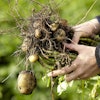Petfood Forum 2006 will be at the Hyatt Regency Hotel,
near Chicago's O'Hare International Airport. The
registration fee includes the four meals and two receptions
listed in the schedule of events (see p. 25). In addition
to our website (www.petfoodindustry.com), you can get more
information about Petfood Forum by E-mailing Marcia Riddle
at [email protected] (attendees) or Dee Henson at
[email protected] (exhibitors).
Make hotel reservations directly with the Hyatt by
calling +1.847.696.1234 or faxing +1.847.698.0139. For a
lower group rate (US$154), make reservations in the Petfood
Forum block of rooms prior to March 15, 2006 and before the
group block is filled.
Lean manufacturing is one of the most tested and
powerful transformation methods today. However, most
companies do not use it in a way that yields its full
potential. Do you know the difference between fake and
genuine lean? Jamie Flinchbaugh will explain. He is a
co-founder of the Lean Learning Center, Novi, Michigan,
USA.
Trade around the world has become a relatively level
"playing field." Numerous technological advances and the
lowering of political/trade barriers have made it possible
to do business instantaneously with billions of people
across the planet. Wallace Tyner, PhD will discuss what
this means to your business. Dr. Tyner is the head of
Purdue University's Department of Agricultural Economics at
Purdue University, West Lafayette, Indiana, USA.
How a company deals with a crisis can determine whether
a brand or company survives. Stephen Payne of The Petfood
Institute (USA), will share ideas for successful management
of a crisis. He will also offer warnings on pitfalls and
discuss how a trade association can help an industry
overcome problems. Steve is The PFI's vice president of
communications. He handles a variety of public relations
and consumer affairs issues and manages The PFI Market
Access Program, a USDA grant funded program to expand
petfood exports overseas.
Over the years, many pet dental homecare programs have
been advocated. Evidence of effectiveness is highly
variable, however. S. Dru Forrester, DVM, Hill's Pet
Nutrition, will discuss a recent Journal of Veterinary
Dentistry report that evaluates various dental homecare
methods. She will talk about current evidence that supports
the use of dental petfoods, chew toys, dental treats, tooth
brushing, zinc salts and other methods. Dr. Forrester
received her DVM from Auburn University and completed an
internship, small animal internal medicine residency, and
Master of Science degree at Texas A&M University.
Benedikt Sas, PhD will describe the benefits of the
probiotic Bacillus subtilis PB6 for companion animals. He
will also discuss its safety aspects, mode of action and
challenges regarding its application. Dr. Sas started as a
chemistry manager for Kemin Europe agrifoods, looking after
the discovery and development of new antimicrobials,
biosurfactants and antioxidants for the agricultural and
petfood businesses. In 2001, Kemin Pharma was founded, and
he took on the responsibility as the president. Kemin
Pharma focuses on the discovery and development of
innovative concepts and drugs for the treatment of
infectious diseases.
Dave Albrecht will discuss how to develop a purchasing
strategy and how to analyze the industry and the supplier
for maximum company benefit. Other points he will cover
include negotiating, sourcing techniques, leveraging,
regulatory compliance and purchasing contracts. Dave has
over 20 years purchasing experience including Fortune 500
companies such as Proctor and Gamble (The Iams Company) and
Campbell Soup. He is currently director of purchasing for
Wells Dairy, a leading US ice cream manufacturer.
Obesity has become one of the most common nutritional
disorders in cats. Obese cats suffer a wide range of health
problems such as diabetes mellitus, thyroid dysfunction,
and hepatic, urological and cardiac disorders. Hussein S.
Hussein, PhD will explain the etiology of feline obesity,
evaluate its health risks and identify strategies for its
prevention. Dr. Hussein is an Associate Professor of
Nutrition and Microbiology at the University of
Nevada-Reno, USA.
David Lummis is the pet market analyst for Packaged
Facts, a division of MarketResearch.com. and author of
"Market Outlook," a monthly column in Pet Products News.
His report will:
Odor can be a big problem for petfood manufacturers.
Non-thermal "cold plasma" odor control is an advanced
technology that has been successfully used by the petfood
industry. Arne Thomas Haaland will present the basic
principles, design considerations and practical experience
with the petfood industry. Arne is with Applied Plasma
Physics (APP) in Stavanger, Norway. APP has been working
with Griffin Cardwell, Louisville, Kentucky, USA, since
2002.
Without the rendering industry, byproducts from meat and
poultry processing would fill up landfills quickly and the
decomposing waste would contaminate our soil and water. In
the last decade, renderers have had more than their share
of problems, especially related to Bovine Spongiform
Encepahlopathy (BSE). Douglas P. Anderson will share his
insights on the state of the rendering industry. Doug is
vice president-rendering at Smithfield Foodsbased in
Smithfield, Virginia, USAthe world's largest pork processor
and producer. He holds officer-level positions with the
National Renderers Association, the World Renderers
Association and the North American Rendering TSE
Coalition.
The Association of American Feed Control Officials
(AAFCO) is considering an amendment of the Model
Regulations that would require a calorie content statement
on all dog and cat food labels. Dr. Dzanis will describe
the label changes that could be required, as well as how
pets, pet owners and manufacturers could benefit. Dzanis is
a consultant for the petfood industry and a former petfood
expert with the US Food and Drug Administration.
Ray Bachelor, a licensed professional engineer, founded
Bachelor Controls, Inc. in 1983. His presentation will
cover how to make better use of your production
information, including:
Greg Aldrich, PhD will explore functional ingredients
that fortify the antioxidant defense system.
Whether dog, cat, mouse or man, antioxidants are crucial
to survival in an oxygenated world. Physiologically
unchecked oxidation can lead to many disease states which
are painful, chronic, and degenerative. Key metabolic
antioxidants, such as glutathione peroxidase and ascorbic
acid, have been shown to protect against oxidative damage.
Dr. Aldrich is a nutrition consultant in the petfood
industry.
Arielle de Jong, of TNO Nutrition and Food Research,
will discuss a multi-discipline approach to petfood
packaging. For example, it can combine expertise focused
on:
Packaging can interact with petfood by actively
regulating conditions, thereby extending shelf-life and
improving safety and quality.
Sumitha Nair from Mintel International, will explore the
global arena of new petfood products. She will analyze some
of the trends that are gaining momentum within the
category, including health, humanization and
specialization. This presentation will also examine a few
rapidly growing ingredient claims and innovative packaging
opportunities, as well as present key regional drivers and
a look at future trends. Sumitha is a senior consultant
with Mintel International Mintel Custom Solutions. She
provides strategic guidance and analysis to a diverse
portfolio of consumer packaged goods clients.
Thomas Meyer is the secretary general of FEDIAF, the
European association of individual country petfood
manufacturer trade associations. He will describe how EU
petfood regulations strive to achieve the best possible
consumer protection and public health policy. Mr. Meyer
will give the legal-technical background, summarize recent
regulatory developments and elaborate in more detail
on:
Thomas is a lawyer who has been Secretary General of
FEDIAF since 1998.
Genetically-modified ingredients, meat and bone meals
and othersyou know how these controversial ingredients
affect your business now, but what about the future? This
presentation goes beyond advocating a position. Juliet
Zavon will use real-world examples and examine how such
controversies can be expected to evolve over time and how
businesses can prepare for the changes. Ms. Zavon is a
multi-lingual management consultant. Her consultations
cover new business opportunities, strategy, valuations,
international operations, strategic alliances and
competitive positioning.
Current research has found new and better ways to detect
and detoxify mycotoxins. Recently, dozens of dogs in the US
died after eating mycotoxin-contaminated, commercial
petfoods. Timothy Phillips, PhD of Texas A&M
University, a widely-respected mycotoxin researcher and
expert, will discuss some of his recent findings and offer
practical advice.
Petfood extrusion is a complex process that is often
considered more of an art than a science. Despite its
complexity, there is a systematic approach to understanding
and training for extrusion by organizing the process into
manageable topical areas. Brian Plattner, PE, manager of
the Wenger Technical Center will cover:
He will examine how these topics impact the critical
product characteristics such as shape and density. He will
also give practical advice on how to manipulate the process
variables to bring a final product back into
specification.
Formulating with new flavors should be highly
collaborative. Kantha Shelke will describe how successful
initiatives involve marketers who provide the concept,
flavor suppliers who provide the aroma compounds,
flavorists who understand the material interactions,
product developers who put it all together and plant
operators who help ultimately to make the flavor system
work. Kantha is a principal at Corpus Blue LLC, a Chicago
firm that specializes in competitive intelligence and
expert witness services.
The concept of good fats and bad fats is one that helps
humans keep track of their dietary habits and heart disease
risk. John E. Bauer, PhD, DVM will discuss how dogs and
cats are different and able to withstand both types of fats
in their diets. For them these fats are either facilitative
or functional. Dr. Bauer is Professor of Small Animal
Medicine and holds the Mark L. Morris Professorship of
Clinical Nutrition at the Veterinary College of Texas
A&M University. His areas of specialization are lipid
biochemistry, disorders of lipid metabolism and comparative
nutrition.
The Asian petfood market is dynamic and growing rapidly.
Eric Combelles, Euromonitor International, will talk about
the characteristics of this market. Japan dominates sales
of dog and cat food. Growth in China, with the second
largest dog and cat food sector in the region, has been
buoyant due to the increasing popularity of mid-priced and
premium dog and cat food. Mr. Combelles monitors the
research for the petfood industry in Euromonitor's key 52
countries.
Information on a petfood label ranges from a statement
as simple as that of net weight to recommendations for use
as dietary therapy for some disease conditions.
Manufacturers view a petfood label as an important aspect
of the product as it communicates something about the
nature of the product to the consumer. Dr. Dzanis will
discuss why it is important that the consumer be aware of
the valuable information on a petfood label. Dzanis is a
consultant for the petfood industry and a former petfood
expert with the US Food and Drug Administration.
Packaging analyst Ben Miyares is the vice president of
industry relations at the Packaging Machinery Manufacturers
Institute. He will explain several ways for petfood
manufacturers to increase packaging productivity,
including:
Miyares is editor and publisher of Ben Miyares'
Packaging Management Update®, a weekly online resource from
PMMI that tracks packaging materials and machinery
technology trends.
Dr. Daniel Carey, director of technical communication in
the R&D division of The Iams Company, will explain why
he thinks animal welfare guidelines should not be
proprietary. He believes that petfood companies need to
compete in other areas: Innovating, processing and
marketing. However, when it comes to animal welfare, he
says petfood companies should be more open and transparent
about what they are doing by:













